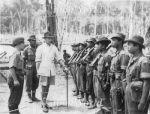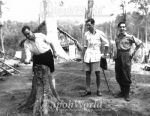We've tried to ensure the information displayed here is as accurate as possible. Should there be any inaccuracies, we would be grateful if you could let us know at info@ipohworld.org . All images and content are copyright.
(Please click on the thumbnail for a bigger image.)
Fort Kemar - The Building Of A Malayan Jungle Fort - Part 2


In the early 1950`s when the Malayan Emergency was at its height, the terrorists of the Malayan Communist Party were on the run in both the urban and rural areas of the country. Their supplies, especially of food, had been severely disrupted by the establishment of the defended new villages, where food for the inhabitants was strictly controlled. Life had also been made more tenuous for them by the increase in informers through the build up of the government intelligence services. As a result, many of their groups had retreated deep into the jungle of the central mountain chain, areas somewhat neglected upto this time by the security forces. In their deep jungle camps the terrorists sought and found the security they desperately needed to grow their own food, to re-group and to train new recruits. They were largely assisted in this by befriending or intimidating the aborigine tribes who roamed the interior.
The aborigines, the Orang Asli as they are now known, were a shy, timid and simple people who lived in the stone age. They were nomadic and lived as family groups in longhouses raised upon stilts in small jungle clearings in which they grew their staple food crops of tapioca, maize and, in some areas, dry rice. After only two or three seasons, or after a death in the family, they would burn their house and move on to new pastures. They fished and hunted using blowpipes with poison darts and they were skilled in making traps of bamboo and rattan. Their jungle craft was unequalled and their tracking skills made it impossible to move anywhere in their tribal areas without their knowledge.
It requires no stretch of the imagination therefore to understand how valuable these people were to the Communist terrorists and how essential it was for the guerillas to cultivate them; and this they did. The Asli knew nothing of the outside world, of government or politics and they were happy to accept at face value, these, apparently, friendly Chinese strangers who convinced them that they were their friends. It also helped that there had been some contact between Communists guerillas and the Asli during the war when the same men had been seen in association with British officers in the fight against the Japanese. This enabled the terrorists to live and cultivate their own crops, largely undisturbed and to receive from the Asli information of security forces movements in the area.
It was obvious that a government presence was required in these areas and it was decided to establish a chain of jungle forts deep in the interior manned by units of the Malayan Police. These were not to be true forts a la Beau Geste, but well-defended jungle camps, the buildings constructed, as are Malay kampong houses, largely from timber cut from the surrounding jungle. Other requirements required for the construction were to be supplied by airdrop.
The role of the forts was to dominate the area in which they were to be situated by providing a permanent police/military base from which to seek out and destroy communist terrorists and their camps and to compromise their courier routes. An equally important role was to bring government to the Orang Asli by providing them in the areas of the forts with medicine, schools and shops and also, eventually, to provide a base for the Department for the Protection of Aborigines. It was hoped furthermore to persuade the Asli to abandon their nomadic way of life and settle around the area of the fort where land would be made available for the more effective farming of their food crops.
The forts were to be manned by the Malayan Police Jungle Companies - independent police para-military units, each identical to an army infantry company in its function and structure and led by both British and Malayan officers. At this time I was a Police Lieutenant and platoon commander in 18 Police Federal Jungle Company, based in a camp on the bank of the Sungei Perak near Grik, a small remote town 15 miles south of the Malaya-Thai border and it was we who were given the task of establishing the country`s most northern fort, deep in the jungle in the area of the Sungei Temengor close to the Perak-Kelantan border; and I was selected, with my platoon, to carry it out.
My platoon consisted of 30 Malay constables, all conscripts, except for my sergeant and corporals who were members of the regular police force. We had been together for two years and by this time they were jungle-hardened warriors in whom I had total trust. My sergeant, Mohamed Yusoff, was a sterling character - a first class leader, likeable and highly respected by the men. I had absolute confidence in them all.
The photographs show a guard formed by some of the Malay constables and commanded by Dennis Wombell, being inspected by Deputy High Commissioner, Sir Donald MacGillivray as the fort reached completion. On the right Sir Donald and Dennis watching DO Grik (D Waites) attempting to use an Asli beliongone to trim the stump of a tree. No doubt he found it more difficult than he expected.
To go to Part 3, click here.
To read more about Sir Donald MacGillivray, click here.
To read more about the Jungle Fort and Airstrips, click here.
For a short introduction to the Malayan Aborigines, click here.